Ciprofloxacin degradation from aqueous solution by Fenton oxidation: reaction kinetics and degradation mechanisms†
Abstract
Pharmaceutical wastewater from a large number of manufacturing units is extremely contaminated by ciprofloxacin (CIP), an antibiotic drug. In this work, aqueous CIP solution was treated by Fenton oxidation (FO). The effects of typical process parameters on drug mineralization have been reported. The optimal Fe2+/H2O2 molar ratio of 0.125 and pH of 3.5 were determined with 15 mg L−1 initial CIP at 25 °C temperature. Maximum CIP, COD and TOC removal of 74.4, 47.1 and 37.9% were obtained under the optimal conditions. The mean oxidation number of carbon determined in terms of COD and TOC values was in accordance with that from the oxidation number of individual carbon atom. The concentration of hydroxyl radicals was measured using the N,N-dimethyl phenyl hydrazine method using dimethyl sulphoxide as a probe. Thirteen fragments appeared in the mass spectra and the proposed mechanism explored the routes of daughter ion formation. The cleavage of the piperazine ring was more effective in CIP oxidation due to high nucleophilic character of lone pair of electrons present on the nitrogen atom. A simple 2nd order kinetic model was proposed for the oxidation of CIP and degradation products (DPs) with respect to OH˙ concentration. The rate constants of 3.13 × 103, 4.89 × 103 M−1 s−1 were estimated for CIP and DPs. The initial concentration of OH˙ was found to be 11.67 μM.


 Please wait while we load your content...
Please wait while we load your content...